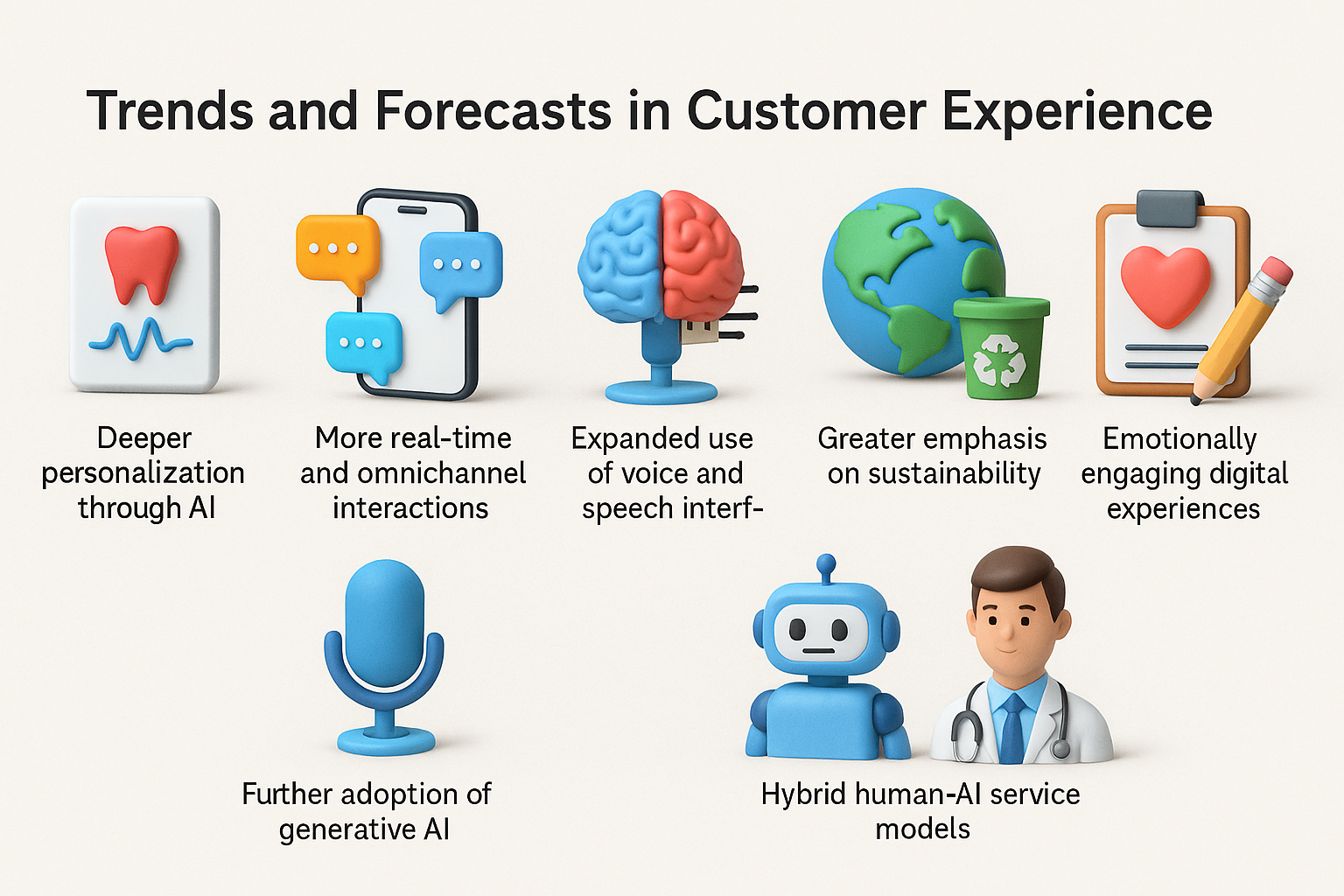Customer experience, often shortened to CX, now defines who wins in competitive markets. It covers every single interaction a customer has with a company from first discovery to repeat purchases. Studies show that companies that invest in CX achieve stronger growth and higher margins than those that neglect it.
In 2024 research confirmed that customer centric companies outperform their peers by over 80% in revenue growth. Businesses that focus on CX also see stronger trust, better retention and more referrals. In this article we will look at ten major reasons why CX must be treated as a core business priority. Each section includes practical details and real data from trusted industry studies.

1. Builds Customer Loyalty
Loyalty is the backbone of stable revenue. A good CX means customers return without hesitation. According to HelpScout 65% of most company revenue comes from existing customers. Winning loyalty is less about offering discounts and more about consistent service, fast responses, and making customers feel understood.
Emotional connections are critical. Surveys show that emotionally connected customers have a 306% higher lifetime value compared to others. They are also more likely to forgive small mistakes. Loyalty also protects businesses during downturns because satisfied customers are less sensitive to small price changes.
2. Enhances Brand Reputation
Reputation is built one interaction at a time. When customers enjoy positive experiences they share them with friends, family and online communities. This builds credibility much faster than advertising. Healthcare data from the CDC shows that providers who focus on patient satisfaction score consistently higher on national surveys.
Reputation can collapse quickly if service fails. In fact 1 poor review can cost a company up to 30 new customers. By investing in CX businesses protect their brand and build trust that money cannot buy.

3. Drives Word of Mouth Marketing
Satisfied customers are the most effective marketing channel. They tell others about their experiences without being asked. Word of mouth is still considered the most trusted source of brand information.
According to Zendesk over 70% of people say they trust peer recommendations more than company advertising. This trust has a direct revenue effect. A Nielsen survey confirmed that 92% of consumers believe recommendations from people they know. Positive CX fuels this cycle and brings organic growth without added ad costs.
4. Increases Customer Lifetime Value
Customer lifetime value or CLV measures how much a customer spends during their relationship with a company. Higher CLV comes from longer retention and larger average purchases.
Research from Harvard Business Review found that improving customer retention rates by 5% can increase profits by as much as 95%. That number shows why CX is a financial strategy as much as a service policy. Customers who enjoy consistent experiences are willing to spend more and engage longer.
Companies that personalize experiences often see CLV double within 24 months. Personalization ranges from tailored offers to proactive support that prevents problems before they grow.
5. Differentiates You from Competitors
Many products look the same in crowded markets. CX becomes the clearest differentiator. When customers remember how a company made them feel, they choose it again.
Airlines, for example, often offer similar pricing, yet the ones known for service lead in loyalty rankings. Businesses in digital sectors now use advanced tools to scale personal CX. Platforms like the Graphlogic Generative AI Platform allow companies to personalize interactions at scale while keeping efficiency high.
Standing out is no longer only about product features. It is about whether customers feel valued in every exchange.

6. Reduces Customer Churn
Churn refers to the rate at which customers leave a business. High churn drains growth because new customers cost more to acquire. Addressing churn means addressing weak CX.
Data from the NIH shows that even in regulated industries like healthcare, organizations with stronger CX report far lower churn. Fixing pain points quickly and ensuring smooth digital and physical touchpoints reduces exits.
For example, telecom companies that introduced real time support and proactive problem solving cut churn by more than 15% in one year. The lesson is clear: customers stay when they feel supported.
7. Boosts Revenue and Profitability
Revenue growth connects directly to CX performance. According to PwC 73% of consumers name CX as a key factor in their buying decisions. Businesses with strong CX strategies enjoy profit margins that are on average 60% higher than peers with poor CX.
Customers who feel valued spend up to 140% more compared to those who do not. Revenue is not only about sales volumes but also about reduced costs of service and fewer complaints. Good CX reduces the load on support teams and improves efficiency across the organization.
8. Encourages Customer Feedback and Improvement
Strong CX cultures welcome feedback. Feedback loops give businesses early insight into what works and what fails. Customers want to be heard and when they see changes based on their input they build stronger trust.
Surveys, online reviews, and quick polls are useful tools. Modern solutions make feedback more inclusive. For instance the Graphlogic Text to Speech API enables companies to reach customers who prefer audio interfaces, expanding feedback channels.
This process drives innovation. Companies that collect regular feedback release updates faster and achieve higher satisfaction scores.

9. Builds Emotional Connections with Customers
CX is not just about speed or convenience. It is also about empathy and recognition. Customers who feel a company understands them are more likely to stay loyal.
Studies reveal that 64% of consumers prefer brands that engage them on a personal level. This may include remembering past purchases or offering tailored solutions. Emotional engagement has measurable outcomes: higher spend, longer retention, and greater tolerance when issues arise.

10. Adapts to Evolving Customer Expectations
Expectations change quickly. What seemed excellent service five years ago feels average today. Businesses that invest in CX adapt faster and avoid losing ground.
During the pandemic telemedicine providers that upgraded digital interfaces saw satisfaction scores climb by more than 20% according to WHO. Customers reward flexibility. Companies that monitor shifts in behavior can redesign CX before competitors catch up.
Trends and Forecasts in Customer Experience
Customer experience is entering a period of fast transformation. Several long term trends will shape how businesses serve and retain their clients over the next decade.
Deeper Personalization and Predictive CX
Personalization is no longer about addressing customers by their first name in an email. With the rise of advanced analytics and generative AI, personalization now includes predicting customer needs before they express them. By 2026 it is projected that 75% of all interactions will be handled by AI powered systems. This will make predictive recommendations, proactive service, and context aware communication standard rather than optional. Companies that invest in predictive models will reduce friction, shorten buying cycles, and increase satisfaction at scale.
Real Time and Omnichannel Engagement
Customers expect consistency across every channel. Whether they connect through phone, chat, email, or social media, the experience must be seamless. Real time response is now seen as a minimum requirement. Industry studies show that over 80% of consumers abandon brands after multiple slow or disconnected interactions. Businesses are therefore investing in unified platforms that connect all communication channels into one continuous journey. This shift demands integration between CRM, analytics, and AI powered tools to prevent gaps and delays.
Growth of Voice and Speech Interfaces
Voice technologies are shaping CX in powerful ways. Virtual assistants, smart speakers, and advanced speech recognition cut wait times and make services more accessible. For customers with disabilities or those who prefer spoken interaction, these solutions improve inclusion. Adoption is rising quickly. Gartner predicts that by 2027 more than 60% of service organizations will use conversational AI to manage support. The expansion of text to speech and speech to text APIs will also enable new ways of gathering feedback and serving global audiences in their native languages.
Expansion of Generative AI for Customer Support
Generative AI is moving from pilot projects to mainstream adoption. Companies are using these models to create dynamic knowledge bases, generate real time responses, and personalize content. Generative AI not only reduces costs but also increases accuracy and customer satisfaction by providing consistent answers. Early adopters are already reporting reductions of up to 30% in support call volume as customers resolve issues through AI enhanced self service.
Sustainability as a Core Experience Factor
Sustainability is no longer only a supply chain or compliance issue. Customers increasingly link their satisfaction to how responsible a brand is. A large percentage of Gen Z consumers report that they avoid companies with weak sustainability records. CX leaders are responding by adding transparency to digital touchpoints, for example showing the carbon footprint of shipping options during checkout. Customers reward companies that demonstrate real commitments to reducing waste and operating responsibly. This trend will intensify as environmental awareness continues to rise globally.
Emotional Engagement and Humanized Digital Experiences
Automation is powerful but emotion remains central to CX. The future will demand a balance between AI efficiency and human empathy. Businesses that succeed will not only answer questions quickly but also show understanding of customer frustrations and needs. Training frontline employees in empathy and equipping them with AI tools to handle routine tasks will free them to focus on complex or sensitive issues. Digital empathy will also emerge as a measurable factor, with businesses tracking how interactions make customers feel, not just how fast they are resolved.
Data Privacy and Trust as Differentiators
With the spread of personalization and predictive analytics, data privacy is becoming a deciding factor in CX. Customers are more willing to share personal information if they trust a brand to protect it. Clear policies, secure platforms, and visible compliance with privacy regulations will become competitive advantages. Companies that fail in this area risk immediate reputational damage. Trust will increasingly be seen as a key component of the experience itself.
Integration of AI and Human Teams in Hybrid Models
Hybrid service models are expected to dominate. AI systems will handle routine questions and data analysis while human teams provide empathy, negotiation, and problem solving. This combination reduces costs while improving quality. Forecasts suggest that hybrid CX teams will become standard in more than 70% of mid to large companies by 2030. Businesses that fail to create a balance risk either alienating customers with too much automation or wasting resources on inefficient manual service.
Industry Specific Innovations
Different industries will adapt these trends in unique ways. In healthcare, CX will include telemedicine platforms with AI assisted triage. In finance, predictive systems will guide customers toward tailored investment and credit products. In retail, hyper personalization will extend to store layouts, online recommendations, and even packaging design. Each sector will adopt the same underlying technologies but with industry specific outcomes.
Long Term Forecast
Looking forward, CX will be shaped by continuous improvement cycles fueled by feedback, AI analysis, and customer expectations that rise each year. Businesses that fail to invest will fall behind quickly because competitors will set new standards. The winners will be companies that combine personalization, speed, sustainability, trust, and empathy in one integrated system. CX is moving from a support function to a full strategic pillar, and its importance will only grow in the next decade.

Key Points to Remember About Customer Experience
- CX builds loyalty and reduces churn
- Good experiences enhance brand reputation and drive referrals
- Strong CX increases customer lifetime value and profitability
- Adaptable CX strategies help businesses stay relevant and competitive
Conclusion
Customer experience is more than a marketing trend. It is a measurable driver of growth and a shield against churn. Businesses that ignore CX take a serious risk in competitive markets. Those that lead in CX build loyalty, trust and long term profit.
By adopting modern tools, listening closely to feedback, and adapting to customer expectations, companies can secure lasting success. CX is not optional anymore, it is the key factor that defines who thrives and who falls behind.
FAQ
Customer experience is important because it affects loyalty, retention, and profitability. Without good CX businesses lose customers quickly and face higher costs to attract new ones.
It drives revenue by increasing lifetime value and creating strong reputations that attract new customers. Positive CX also reduces costs by lowering churn and limiting complaints.
Companies can improve CX by listening to feedback, personalizing communication, and ensuring fast resolution of issues. Tools that integrate AI can also make interactions smoother without losing human warmth.
Metrics include Net Promoter Score, churn rate, and customer lifetime value. Combining survey data with actual behavioral data gives the most accurate picture.
All industries benefit, but retail, healthcare, finance, and digital services see particularly strong returns. These sectors face intense competition and high customer expectations.
Some improvements like faster response times can raise satisfaction within weeks. Larger programs such as AI integration may take months but bring long lasting gains.

